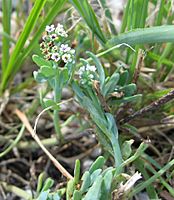Salt heliotrope facts for kids
Quick facts for kids Salt heliotrope |
|
|---|---|
 |
|
| variety oculatum in California | |
| Scientific classification | |
| Genus: |
Heliotropium
|
| Species: |
curassavicum
|
Heliotropium curassavicum, often called salt heliotrope, is a type of flowering plant. It belongs to the borage family, known as Boraginaceae. This plant naturally grows across a huge area of the Americas. You can find it from Canada all the way down to Argentina. It also grows in the Caribbean and Hawaii.
Sometimes, this plant spreads to new places. It has been introduced to Africa, Asia, Australia, and Europe. In some of these places, it can even become an invasive species. Heliotropium curassavicum loves salty ground. This includes places like sandy beaches, dry lakebeds with salt, and salt marshes. It often grows in coastal areas that have been disturbed by people.
Contents
What Does Salt Heliotrope Look Like?
This plant is a perennial herb. This means it lives for more than two years and has soft, non-woody stems. It can grow in different ways. Sometimes, it spreads low to the ground like a creeper. Other times, it stands up straighter, like a small shrub. It can reach about 0.5 m (1.6 ft) tall.
The stems and leaves of the salt heliotrope are thick and fleshy. Its leaves are usually oval or shaped like a spade. The plant produces many inflorescences, which are groups of flowers. These flower clusters are curled and look like double rows of small, bell-shaped flowers. Each flower is white and has five rounded parts. The center of the flower is purple or yellow. After the flowers, the plant produces a smooth, small fruit called a nutlet.
Different Names for Salt Heliotrope
Because Heliotropium curassavicum grows in so many different countries, it has many common names. People in different places call it by different names.
In English, some common names are:
- Seaside heliotrope
- Salt heliotrope
- Monkey tail
- Quail plant
- Chinese parsley
In Latin American Spanish, it is known as:
- Cola de mico
- Cola de gama
- Rabo alacrán
In Hawaii, people call it kīpūkai.
Types of Salt Heliotrope
Scientists have identified five different types, or varieties, of Heliotropium curassavicum. These varieties are slightly different from each other and grow in specific regions.
- H. curassavicum var. argentinum: This variety is found in the tropical parts of South America. This includes countries like Argentina, Brazil, Paraguay, and Uruguay.
- H. curassavicum var. curassavicum: This is the most common variety. It grows naturally from the eastern U.S. down to Argentina. It has also spread and now grows on seashores in many other parts of the world.
- H. curassavicum var. fruticulosum: This type only grows in the San Juan and Mendoza provinces of Argentina.
- H. curassavicum var. obovatum: This variety is common in western North America and in Chihuahua, Mexico.
- H. curassavicum var. oculatum: You can find this variety from southwestern Utah to Baja California.
-
Variety curassavicum has the smallest flowers, only 2.5-3.5 mm wide (Bahia Honda Key, Florida)
-
Variety obovatum has flowers 5-10 mm wide, with yellow or slightly purple-tinged throats (Moapa Valley, Nevada)
-
Variety oculatum has flowers 3-5 mm wide with purple throats (Marin County, California)
See also
 In Spanish: Heliotropium curassavicum para niños
In Spanish: Heliotropium curassavicum para niños




